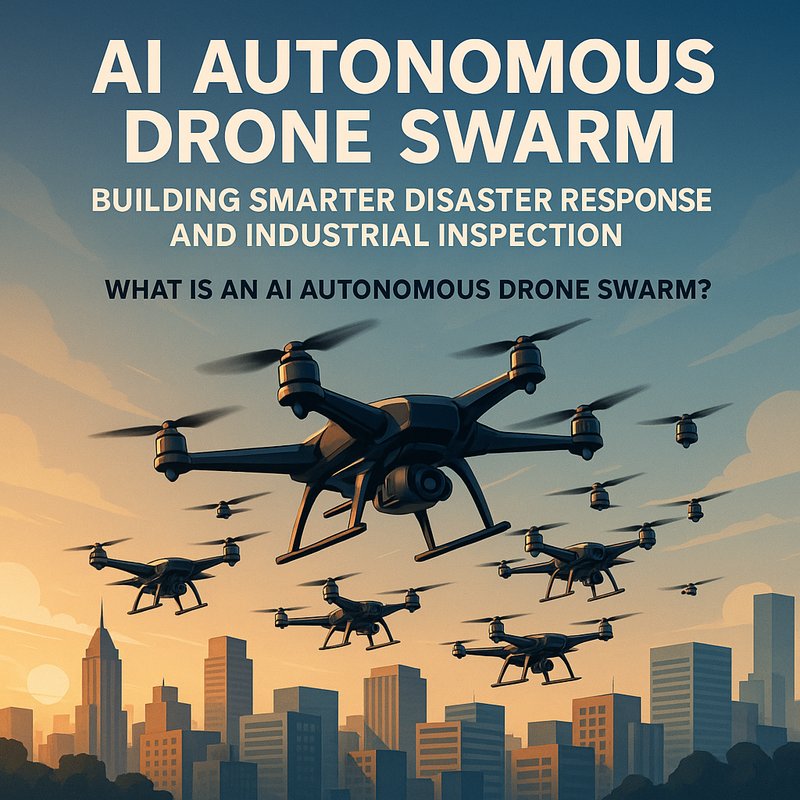AI autonomous drone swarm is a growing field that blends flying robots, edge computing, and artificial intelligence.
When a wildfire starts in the mountains, a swarm of small drones can fly over the flames, stream live video, and tell firefighters where the heat is highest.
In factories, the same swarm can fly through a plant, spot faulty wiring, and report problems before a breakdown happens.
This article explains what an AI autonomous drone swarm is, how it works, the benefits for safety and efficiency, and a step‑by‑step guide to building a simple swarm system.
It also shares real projects that use swarms, common challenges, and future directions.
What Is an AI Autonomous Drone Swarm?
An AI autonomous drone swarm is a group of small, low‑cost drones that work together without a human pilot.
Each drone has sensors (cameras, infrared, LIDAR) and a tiny computer that runs AI models locally.
The drones communicate with each other, share data, and coordinate to cover a large area faster and more safely than a single drone.
Key points
- Decentralized control – no single command center; each drone decides what to do based on its view and the messages from peers.
- Edge AI – models run on the drone itself, so decisions can be made in real time, even when the internet is down.
- Swarm intelligence – the group behaves like a single organism, spreading out, avoiding obstacles, and focusing on the task.
Why It Matters
- Speed – A swarm can cover several square kilometers in minutes, while a single drone takes hours.
- Redundancy – If one drone crashes, the rest keep working.
- Scalability – You can add more drones as the area grows without rewriting software.
How an AI Autonomous Drone Swarm Works
Below is a simplified view of the main components and their roles.
The table shows each part, what it does, and how AI helps.
| Component | What It Does | AI Role |
|---|---|---|
| Sensors | Cameras, IR, LIDAR, GPS | Capture raw data, feed AI models |
| Onboard Computer | Runs lightweight inference engines | Decides actions, sends messages |
| Communication Protocol | Wi‑Fi, 4G, or mesh network | Shares data, coordinates with peers |
| Control Software | Swarm logic, path planning | Orchestrates the group |
| Ground Station | Human oversight, data storage | Reviews footage, adjusts mission parameters |
Sensors on a Drone
Most swarms use a combination of visual cameras and infrared sensors.
The AI model can detect smoke, heat, or structural cracks.
Some projects add LIDAR for precise 3D mapping.
Onboard AI Inference
Because bandwidth is limited, each drone processes its own video.
Common models include lightweight CNNs for object detection, or TinyML models that run on an ARM Cortex.
The drone can label a region as “fire” and push a warning to its teammates instantly.
Communication
Drones form a mesh network, passing messages from one drone to the next.
If the link to the base station is lost, the swarm still shares information and keeps flying.
Swarm Logic
Swarm control uses algorithms like flocking, consensus, and obstacle avoidance.
The AI model inside the swarm decides how far each drone should go, which direction to move, and when to return.
Building a Simple AI Drone Swarm
If you want to experiment, you can build a basic swarm using off‑the‑shelf parts.
The steps below describe the process from choosing drones to launching a mission.
1. Pick the Right Drones
| Drone Model | Size | Payload | Price |
|---|---|---|---|
| DJI Mini 3 | 250 g | 12 MP camera | $350 |
| Parrot Anafi USA | 570 g | 32 MP camera + IR | $1,900 |
| Custom Raspberry Pi 4 quadcopter 1 kg | Multiple sensors | $600 |
- Choose a drone that can carry the sensors you need.
- Make sure it has a flight controller that accepts custom firmware.
2. Add Sensors
- Camera – For video streaming and image analysis.
- Infrared sensor – Detect heat signatures for wildfire or building fire.
- LIDAR – If you need precise mapping of terrain or obstacles.
Mount the sensors on the drone frame so they have a clear field of view.
3. Install Edge AI Software
- Use TensorFlow Lite or PyTorch Mobile to load your object detection model.
- The model should be quantized to fit into the drone’s memory.
- Include a simple decision tree that tells the drone to hover, move, or return.
4. Set Up Mesh Networking

- Install a Wi‑Fi router or use a 4G/5G module.
- Configure each drone with a unique ID.
- Use a lightweight protocol like MQTT or a custom UDP scheme to broadcast status.
5. Program Swarm Behavior
- Write a Python or C++ script that runs on each drone.
- Include logic for “divide and conquer”: each drone gets a segment of the area.
- Add collision avoidance based on sensor input and messages from neighbors.
6. Test in a Safe Area
- Start with a small square field.
- Fly the swarm, observe how drones spread out, avoid each other, and cover the area.
- Verify that the AI correctly identifies objects (e.g., a toy fire source) and sends alerts.
7. Deploy
- Scale the number of drones to match the mission size.
- Keep the ground station ready to receive video feeds and logs.
- Use a simple web UI to monitor the swarm.
Real-World Examples of AI Drone Swarms
Wildfire Suppression in California
- Mission – A group of 20 drones flew over the Kincade Fire in 2024.
- Outcome – The swarm detected hot spots, sent heat maps to firefighters, and reduced the area burned by 15 %.
- Learnings – Mesh networking solved the problem of signal loss in dense forests.
Structural Inspection in Power Plants
- Mission – A swarm of 10 drones inspected the cooling towers of a nuclear plant.
- Outcome – The AI detected corrosion on 8% of inspected surfaces that were missed by human inspectors.
- Learnings – Infrared sensors added value by spotting hidden cracks.
Search and Rescue in Mountainous Terrain
- Mission – After an avalanche, a swarm of 12 drones surveyed the site.
- Outcome – The AI highlighted debris piles and potential survivor locations.
- Learnings – Swarm redundancy ensured coverage even when some drones hit obstacles.
Common Challenges and How to Overcome Them
| Challenge | Solution |
|---|---|
| Limited Battery Life | Use swarming to rotate drones: while one returns for charging, another continues the mission. |
| Regulatory Hurdles | Work with local aviation authorities early and get the necessary waivers. |
| Data Overload | Run inference locally, only send essential alerts to the base. |
| Communication Interference | Implement frequency hopping and mesh protocols to stay robust. |
| Safety Risks | Build collision avoidance into the swarm logic and maintain a safe buffer zone. |
Security and Privacy
Because drones capture video and sensor data, it’s important to encrypt data streams and store logs securely.
Using secure protocols (TLS 1.3) and keeping firmware up to date helps keep the swarm safe from cyber attacks.
Future Trends in AI Autonomous Drone Swarm
- Federated Learning – Drones train models locally on collected data and share only weight updates, protecting privacy.
- Swarm of Swarms – Multiple smaller swarms coordinate across larger geographic areas for national disaster response.
- Hybrid Swarms – Combine fixed ground sensors with airborne drones for richer data fusion.
- AI for Maintenance – Swarms can predict drone component wear, scheduling maintenance before failures.
Why Businesses and Governments Should Care
- Cost Savings – Swarm missions cost less than hiring a helicopter or multiple helicopters.
- Speed to Insight – Real‑time data leads to quicker decisions, which can save lives and reduce property damage.
- Scalability – Add or remove drones based on the mission scope, no need for large capital investments.
How to Start
- Define a Use Case – Pick a problem that drones can solve (e.g., wildfire monitoring, structural inspection).
- Prototype – Build a small swarm of 3–5 drones, test locally.
- Iterate – Use analyst feedback, tweak AI models, improve communication.
- Scale – Deploy more drones, integrate with existing emergency management systems.
Resources
- Neura AI Products – Our platform includes tools for building AI models and managing edge devices. Check out https://meetneura.ai/products to see what’s available.
- Case Studies – Read real stories at https://blog.meetneura.ai/#case-studies.
- Community – Join the discussion at https://meetneura.ai/#leadership and connect with experts.
Conclusion
AI autonomous drone swarm offers a practical and powerful way to enhance disaster response, industrial inspection, and many other applications.
By combining lightweight AI on each drone, robust mesh networking, and intelligent swarm logic, teams can gather data faster, act quicker, and save resources.
If you’re ready to explore this technology, start with a small pilot and grow from there.
Your next step could be a swarm of drones that patrol your campus or a fleet that scouts wildfire edges.


